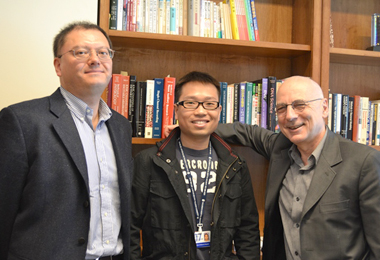(l to r) Takao K. Hensch, Henry H.C. Lee, and Alain Prochiantz
A small group of highly metabolically active neurons act as conductors in the symphony that is cortical development. The movements of this symphony are the ‘critical periods’ of plasticity in which our experiences sculpt neural circuits—timed differently for different cortical areas and functions, but building upon each other in a precise sequence. The conductor neurons, known as parvalbumin cells (PV-cells), are a subset of inhibitory GABA interneurons that synchronize the activities of large populations of projection neurons across the cortex and direct the onset and closure of critical periods. Their role is so pivotal that altering their status can restore juvenile-like plasticity in the visual system of adult animals, and abnormalities in these cells are believed to underlie the pathology of major developmental disorders such as autism and schizophrenia.
A new study from the laboratories of Takao K. Hensch, Professor of Molecular and Cellular Biology at Harvard University and Professor of Neurology at Harvard Medical School and Boston Children’s Hospital, and Alain Prochiantz, Professor of Neurobiology at College de France, published online June 13th in Cell Reports, reveals a surprising behind-the-scenes player in this symphony: the choroid plexus.
This blood-brain barrier structure—not previously linked to plasticity—turns out to be an essential source of the Otx2 homeoprotein that regulates PV-cell maturation and, consequently, the ability to open and shut critical periods. Hensch and Prochiantz’s teams had discovered the plasticity powers of Otx2 in 2008, while studying a critical period for binocular development in the mouse visual cortex. When there is insufficient Otx2, PV-cells in the visual cortex fail to mature and the critical period does not open. Conversely, infusing Otx2 early in development accelerates PV-cell maturation and the critical period begins earlier.
One of the most interesting observations from this initial study was the fact that Otx2 is not made in PV-cells—or anywhere else in the cortex. Instead, some of it comes from the eyes. This is functionally significant because blocking the transfer of Otx2 from the eyes to the cortex can block binocular visual development. However, because Otx2 protein is found across the entire cortex, not just visual areas, the researchers looked for additional sources.
In the present work, led by co-first authors Henry H.C. Lee, a postdoctoral fellow in the Department of Molecular and Cellular Biology and Julien Spatazza, formerly a graduate student at College de France, in situ hybridization identified the choroid plexus as a novel site of Otx2 production in adult mice. Acute genetic disruption of Otx2 in the choroid plexus decreased its levels in the cortex and restored a juvenile-like state to the adult visual system—powerful enough to allow correction of amblyopia, a visual impairment that, while treatable in youth, is usually irreversible in adulthood. Expression of the PV-cell marker parvalbumin was diminished, as was a marker for perineuronal nets (PNNs), the sugar rich extracellular matrix structures that enwrap PV-cell bodies as they mature and facilitate their uptake of Otx2. By comparison, a marker for a closely related class of GABA interneurons was not affected.
The Cell Reports study comes straight on the heels of another study on the cell extrinsic regulation of PV-cells, published online May 13th in Proceedings of the National Academy of Sciences (PNAS). Led by Kim Q. Do at the University of Lausanne in Switzerland in addition to Hensch, this study reveals that PNNs act as shields protecting PV-cells from oxidative stress, a problem common in many psychiatric disorders. The report focuses on PV-cells of the prefrontal cortex, and examines the impact of oxidative stress triggered both by genetic impairments and environmental insults.
Together these findings provide insights that could guide the development of new therapies for brain disorders. “The PV-cell is vulnerable in many mental illnesses,” says Hensch, also director of the Conte Center at Harvard, a basic research group focused on developmental origins of mental illness and a member of the Center for Brain Science. “So if we can find a way to maintain its health and wellbeing then we might have a way to treat mental illnesses that show this phenotype.”
The discovery that the choroid plexus is an essential source of a factor constraining adult cortical plasticity is particularly exciting in this regard because this structure is accessible through the peripheral bloodstream.
Read more in Cell Reports
Download PDF
Read the full study in PNAS
Read the related Boston Children’s Hospital Vector blog post


